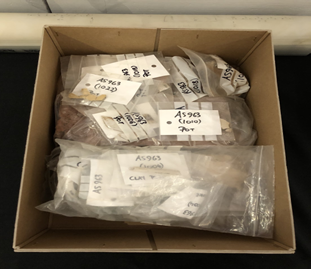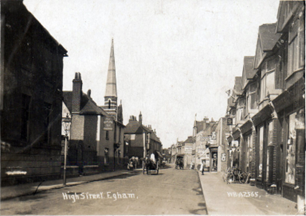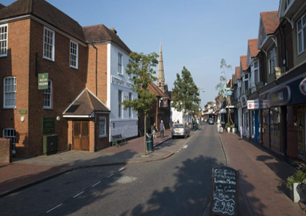THE RED LION, EGHAM HIGH STREET
At over 600, ‘Red Lion’ is the most popular pub name in the UK, referring to either the crests of John of Gaunt (Ghent), one of the richest men of the 1300s and founder of the House of Lancaster, or King James I and IV of Scotland1. Egham High Street is no different – despite several restoration projects over the years, and changing landlords, the earliest record of the name for the Egham’s Red Lion dates back to 1641, in relation to a report on a servant who died of smallpox2. However, the brickwork is even older, according to the 1521 datestone, some of which is in our collection3. As a result, the Red Lion is Grade II listed. Beyond the building itself, ancient pottery was also found on site, donated to the museum in 19934. Furthermore, a 2006 archaeological survey at the rear of the pub, including a trial trench evaluation (see below), associated the Egham High Street with prehistoric occupation, specifically the Bronze and Iron Ages; although no such evidence remained, they found various items such as brick, pottery, and even an animal bone5.
As the Red Lion, the building was used as a coaching inn with stabling for 72 horses, for passenger and mail coaches on the London-Penzance road, which served the coastal towns of Exeter, Southampton, and Weymouth twice a day, while more local journeys were up to four times a day6. A practice dating from at least 1795, this suggests Egham’s centrality within South England prior to its industrialisation; as demonstrated by the alphabetised catalogue of passing coaches passing through the high street in 18287, even if it increased the likelihood of the plague or highway robbery within the community8. Unfortunately, with the construction of Great Western Railway under Brunel, coaching rapidly declined from the 1840s9. More locally, however, the Red Lion was essential to Egham Races until their discontinuation in 1884 both for registering competitors and stable the horses10. Despite the loss of income from public transport, the pub remained popular: there is an inscribed pane of glass in our collection, with an accompanying letter, that suggests the pub was frequently visited by the king’s soldiers during visits to Windsor Castle (known as the Life Guards from the exile of Charles II), most likely in 1827 under the declining reign of George IV11 (see below). The Chertsey Petty Sessions in 1892 also stated that the pub’s demographic was ‘working class and beanfeasters’, the latter of which is 19th century slang for celebratory food and drink12.
However, the building was not just a pub. Today’s outdoor seating area was a dispensary from 1859 until 1921, serving 1750 patients yearly by 191313. Meanwhile, the adjacent building was used as its dancehall, theatre, and general social club, ‘The Assembly Rooms’, from 1788 until 1854. Members met once a fortnight and anyone who did not attend without prior notice was fined14. Today, it is the Literary Institute, which was vital during both World Wars andnow includes Egham Museum. Many of the building’s original activities have been restored in recent years, as well as business meetings for local organisations15.
Ultimately, Egham’s Red Lion is not only a landmark within the local area but also reflects Britain’s wider historical events, regardless of social class. Pubs were, and still are, essential to British society and culture in general, whether it is based on the location, purpose, or the inhabitants, not just food and drink!
1 Dunkling, L. and Wright, G., The Wordsworth Dictionary of Pub Names (Ware: Wordsworth Editions, 1994), pp.138, 218.
2 DOC4114 (letter).
3 MC350 (brick), DOC4118 (card).
4 MC349 (pottery).
5 MC1184 (archeological survey).
6 DOC2114 (notes), DOC4114, DOC4118, DOC4127 (memoir) & The Oliver Collection, ‘The Public Houses of Egham’ [online], ‘available at: http://personal.rhul.ac.uk/uhyl/007/pubsegham.html (July 2016).
7 DOC443 (timetable) [on display] & The National Library of Scotland, A correct list of all the coaches passing through Egham for the year 1828 (Egham: C.C. Wetton, 1928).
8 Egham Museum, ‘Crime and Highway Robbery in Egham’ & ‘The Plague Comes to Egham’ [online], available at: https://eghammuseum.org/crime-and-highway-robbery-in-egham/ & https://eghammuseum.org/the-plague-comes-to-egham/.
9 DOC416 (notes).
10 Egham Museum, ‘Egham Races’ [on display & online], available at: https://eghammuseum.org/egham-races/.
11 Egham Museum, ‘Inscribed Pane of Glass from the Red Lion High Street’ [online], available at: https://eghammuseum.org/inscribed-pane-of-glass-from-the-red-lion-high-street/.
12 DOC379 (record), DOC2110 (notes).
13 DOC4127.
14 DOC2110, DOC4118, DOC4127.15 The Oliver Collection, ‘Literary Insititute’ [online], available at: http://personal.rhul.ac.uk/uhyl/007/literaryinstitute.htm (September 2013) & The Literary Institute [online], available at: https://www.atthelit.org/.









